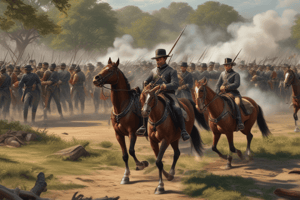Podcast
Questions and Answers
What role did Hammond play during the Civil War?
What role did Hammond play during the Civil War?
- He advocated for women's rights in nursing
- He trained nurses for the Union Army
- He developed new medical treatments
- He standardized and organized hospital layouts (correct)
What facilitated the spread of improved medical techniques during the Civil War?
What facilitated the spread of improved medical techniques during the Civil War?
- The establishment of specialized medical schools
- The widespread availability of medical personnel (correct)
- The development of new surgical procedures
- The availability of advanced medical equipment
Which of the following was introduced during the Civil War period?
Which of the following was introduced during the Civil War period?
- Efficient hospitalization systems (correct)
- Advanced surgical techniques
- Specialized medical schools for nurses
- Antibiotics for treating infections
How did the Civil War influence society's perception of nursing as a profession for women?
How did the Civil War influence society's perception of nursing as a profession for women?
When were the first nursing schools in America established?
When were the first nursing schools in America established?
What did the pioneering nursing education system instill in nurses?
What did the pioneering nursing education system instill in nurses?
Which of the following figures played a significant role in advancing nursing care during the Civil War?
Which of the following figures played a significant role in advancing nursing care during the Civil War?
What was Clara Barton's contribution to nursing care during the Civil War?
What was Clara Barton's contribution to nursing care during the Civil War?
How did Jonathan Letterman contribute to the advancement of medical care during the Civil War?
How did Jonathan Letterman contribute to the advancement of medical care during the Civil War?
Which aspect of medical care underwent significant improvements during the Civil War?
Which aspect of medical care underwent significant improvements during the Civil War?
What was the primary challenge faced by medical personnel during the Civil War?
What was the primary challenge faced by medical personnel during the Civil War?
What was a notable outcome of the advancements in medical care during the Civil War?
What was a notable outcome of the advancements in medical care during the Civil War?
Flashcards are hidden until you start studying
Study Notes
During the American Civil War, nursing care underwent significant advancements as both sides struggled to cope with the immense burden of caring for wounded soldiers and dealing with diseases that plagued them. These difficulties led to improvements in medical practices and the establishment of key institutions and figures instrumental in shaping the future of nursing.
In the midst of the chaos and carnage, nurses, surgeons, and physicians worked tirelessly to heal a nation and bring medical care into the modern age. Despite the challenging conditions, they made strides in improving patient outcomes and establishing new standards for medical care. One notable figure was Clara Barton, a humanitarian and founder of the American Red Cross, who brought professionalism and organization to soldiers in the field. She famously delivered much-needed medical supplies and administered care at the Battle of Antietam.
Another important figure was Jonathan Letterman, the Medical Director of the Army of the Potomac, who introduced order and efficiency into the medical service with a regulated ambulance system and evacuation plans. Under his leadership, ambulances transported the wounded effectively from the battlefield to field hospitals, followed by pavilion hospitals once the wounded reached larger cities.
As medical practice evolved, so too did hospital design and organization. William A. Hammond, the Surgeon General of the Union Army, played a crucial role in standardizing, organizing, and designing new hospital layouts. His efforts culminated in a comprehensive guide on hygiene for the army, reflecting the growing importance of hygiene and sanitation in preventing the spread of disease.
The widespread availability of medical personnel during the war allowed for the rapid dissemination of improved medical techniques and treatments. This period saw the introduction of efficient hospitalization systems, which slowed the spread of bad practices and facilitated access to effective treatments for the sick and wounded.
Postwar, the experience of nursing during the Civil War greatly influenced society's perception of nursing as a viable, professional occupation for women. The work of Civil War nurses demonstrated that women could deliver excellent care to men outside their families without compromising their delicacy or reputation.
After the war, American nursing schools began accepting women as students. The first nursing schools, established around 1873, were modeled after Florence Nightingale's schools in England. The pioneering nursing education system laid the foundation for the development of modern nursing practices and instilled a sense of pride and duty among nurses to serve their communities and nation.
Studying That Suits You
Use AI to generate personalized quizzes and flashcards to suit your learning preferences.




